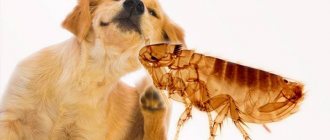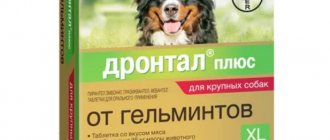Every dog is at risk of contracting helminthiasis even before its birth from a mother who has not been treated and prevented. Many pet owners are confident that dogs living in a house or apartment cannot become infected with parasites. In fact, this is not so; more than 70% of pets are found to have worms.
It is necessary and important for owners of shaggy pets to know what deworming is, how to properly care for a dog, what deworming medications for dogs to use if helminths are detected, and how to cure a pet from this dangerous disease. All this will be discussed in this article.
Danger
The behavior of the animal must be constantly monitored, since even a domestic dog can become infected by simply drinking water from a puddle or grabbing a ball from the ground with its teeth.
A sick dog's immunity is sharply reduced, as a result of which it will be vulnerable to many other diseases. The effectiveness of vaccinations decreases sharply, which explains the need for deworming before vaccination. Moreover, worms, living in the internal organs, cause mechanical damage to them and literally feed on the dog. If the disease is not cured in time, great harm to the animal’s health and even death is possible.
Should puppies be bred before they are one year old?
Puppies are allowed to take anthelmintic drugs from 3-5 weeks of age. Worming periods for puppies:
- It is necessary to carry out the first procedure of cleansing the body before vaccination. If the puppy was taken from home breeding or a kennel, most likely the mother was wormed before mating, and a single procedure is enough for such a puppy.
- If the puppy is removed from the street environment, or it has obvious signs of helminthic infestation, you will need to consult a veterinarian and possibly re-treat it. Only after this can he be vaccinated.
How many times can you poison?
Puppies are at risk; they are more susceptible to infection, so up to a year of age, prevention should be carried out every 3 months.
Signs
An attentive owner can, without visiting a veterinary clinic, understand that his beloved pet has worms; all he needs to do is watch him.
There are several main signs of infection:
- changes in habits and behavior: lethargy, apathy, tendency to dermatosis and eczema;
- changes in the gastrointestinal tract: decreased appetite or good appetite due to weight loss, changes in taste preferences, vomiting, diarrhea, constipation;
- the presence of blood, mucus, larvae or worms themselves in the stool;
- swollen and hard belly, protruding ribs;
- developmental and growth retardation;
- difficulty swallowing;
- itching of the anus (the dog “rides” on the back of the body in an attempt to get rid of it).
Prevention for large and small breeds
In terms of the frequency of preventive measures, there is no difference between large and small breeds. There are differences in the drugs used. For small and problem (allergic) breeds, the anthelmintic, dosage and frequency of cleaning procedures should be prescribed by a veterinarian. Usually these are milder drugs, like those for puppies.
If for large breeds tablets are preferable, since they have a more pronounced effect and speed of action, then for small breeds the bulk is made up of suspensions.
Types of worms
Traditionally, it is customary to distinguish three main types of worms:
- Round (nematodes) : spindle-shaped, tapering at the ends. In nature there is a huge variety of species of these helminths (about 1,000,000); some species can reach 8 meters in length. These include: roundworms, pinworms.
- Ribbon, flat (cestodes) : they have a ribbon-like, long body at one end of which there is a head. When it enters the animal’s intestines, the head turns out, sticks to the intestinal walls, and the helminth begins to grow, reaching a length of 10 meters. The most famous representatives: pork tapeworm, bovine tapeworm, broad tapeworm.
- Flukes (trematodes) : these worms are distinguished by the presence of suckers not only in the front of the body, but also in the middle. Due to the peculiarities of their structure, they can live in many internal organs, and their offspring are innumerable, since new embryos are already developing in each larva. These worms include: liver fluke and cat fluke.
In addition to the above division of helminths, it is possible to carry out a classification depending on the organ in which they parasitize, these could be esophageal worms, heart worms, and so on.
What do you think about the drug "Profender"?
Most owners think that tablets are a priori better, because... worms in the intestines, the tablet is sent there. “Profender” has been tested on hundreds of cats, starting with my own cat. There were several cases of misfires - this is acceptable because Any even super drug works with about 99% efficiency.
This drug is absorbed from the skin into the blood and kills Toxocara larvae, and then excreted with bile into the intestines and kills adults there. When using the drug, dead helminths will be excreted in the feces 2-3 days after using the drug. Those who use pyrantel are accustomed to the fact that helminths come out within the first day, and without waiting for the effect, they sometimes go to the store for a pill.
What to do if the dog is already infected
As mentioned above, puppies can get worms from their mother even before birth, and deworming puppies has its own characteristics. In this regard, there is a need to deworm a newly acquired puppy, at least for prevention, even if no symptoms of infection are observed.
In this case, you must follow several rules:
- If you plan to deworm your dogs before vaccination, be sure to inform your veterinarian about possible helminths, he will select a remedy for this case.
- It is best to carry out deworming between February and March; at this time, deworming of dogs is most effective.
- Only an otherwise healthy pet can be treated for fleas; even fleas should be treated before the procedure, otherwise the drug should be prescribed by a doctor.
- Depending on the breed, some individuals may not tolerate deworming medications well; check this with your veterinarian.
- Be sure to check whether the bitch received prophylaxis before pregnancy; the time of the first dose of medication will depend on this.
What is deworming
Deworming of dogs is a measure aimed at destroying existing parasites or preventing their appearance. To become infected with worms, it is not necessary to come into direct contact with an infected animal. The eggs are transmitted through insect bites, are released along with the feces of a sick dog, fall on the soil and are carried by human shoes. Even those pets who practically never leave the house are at risk of infection.
Deworming is carried out in the form of feeding the animal a tablet or liquid containing substances harmful to parasites. In some cases, it is possible to use drops and pastes.
Choosing an anthelmintic drug
All anthelmintic drugs for dogs are divided into two large groups: universal (great for prevention) and special (prescribed for more effective treatment of a specific type of parasite, which is determined by the veterinarian based on test results). Particular care should be taken when choosing anti-worm medications for puppies, since incorrect selection of the drug and excessive dosage can be fatal.
If you decide to treat your pet yourself, be sure to read the contraindications and dosage of the drug. If precautions are not taken when using deworming tablets for dogs, the pet can be seriously harmed, and if the dose of the medicine is insufficient, the long-awaited positive effect will not occur.
Dogs should be dewormed about 4 times a year, and this activity may be related to the dog’s lifestyle. For example, prophylaxis should be carried out on a bitch 2 times a year after estrus, as well as before and at the end of the summer season.
And remember, it is possible to determine helminth infection by symptoms only when the animal is already heavily infected. Characteristic signs of helminthiasis indicate that internal organs are already affected. In this case, it is best to immediately consult a doctor; you should not select deworming tablets for dogs on your own.
Contraindications and negative consequences
Frequent use and incorrect dosage can lead to severe poisoning, so consult your veterinarian before using anthelmintics. Regular testing will help identify the type of parasite and avoid taking complex medications with a more detrimental effect on the body.
Contraindications for taking anthelmintics include:
- severe exhaustion and weakened immunity associated with flea infestation, recent surgery, young age or chronic diseases;
- early pregnancy and lactation.
In addition to the toxic substances contained in antiparasitic drugs, the waste products of helminths have a negative effect on the body. Due to existing intoxication, the dog may experience the following side effects:
- mucous vomiting and watery diarrhea;
- refusal of food and water;
- lack of coordination;
- dilated pupils;
- blanching or blue discoloration of mucous membranes;
- convulsions;
- increased salivation;
- constipation with complete absence of bowel movements.
To minimize the effect of toxins, give your pet a sorbent and contact a veterinary clinic. Inducing vomiting or other first aid methods may worsen the animal's condition.
How to carry out the deworming procedure
Deworming is an important part of caring for a pet’s health and must be carried out with full responsibility, because the pet’s condition depends on the owners. Of particular note: these activities are carried out differently in puppies and adult dogs.
Treatment regimen for puppies
The very first time puppies are given medications 2 and 4 weeks after birth, then they are vaccinated on the 42nd day. This scheme for deworming puppies is explained very simply: due to the fact that most often puppies are infected already in the womb, by the time of the first dose, adults have already developed in their body, it is precisely for their destruction that the administration of deworming drugs is aimed.
During the second dose, helminths also grew from the larvae deposited in the puppy’s body; they will die this time, but their larvae will remain. As you might guess, this process is almost impossible to stop, but you can at least partially alleviate the puppy’s illness.
Puppies under 6 months of age are given canine deworming medications approximately once a month, then quarterly. Your veterinarian will help you determine the time of your appointment more accurately. In addition, professionals advise giving dewormers for dogs together with sorbents, as this will reduce the load on the liver from toxins released by dying worms. Most often, Enterosgel is used for this purpose at the rate of 1 tsp. by 10 kg. dog's weight - an hour before feeding for 3 days.
Treatment regimen for adult dogs
When treating adult dogs, first of all, you should pay attention to the animal’s lifestyle. Dogs that are often outdoors or in public places are at high risk of becoming infected. They need to take anthelmintic drugs for dogs every 1-2 months; pet dogs are wormed once a quarter. In any case, this event should be held at least twice a year.
A dog that has given birth to puppies should not be treated while the puppies are drinking its milk.
It is worth using deworming tablets for dogs at intervals of 10 days. This is due to the fact that the medicine does not act on the larvae, and a single dose will have virtually no effect. It is imperative to deworm all animals in the house; the health of both the owners and their children depends on this.
You can also use traditional methods of treating dogs for worms, but only if it is not possible to purchase a special medicine. For the greatest effectiveness of such drugs, they should be used as additional drugs between medications. Independent use of folk remedies alone will not be effective, since they do not kill the larvae and helminths living in the internal organs of the dog.
Unscheduled deworming
There are several cases when it is necessary to carry out unscheduled deworming of pets:
- approximately 2 weeks before vaccination;
- before mating, so as not to infect the puppies;
- if there was contact with infected animals;
- the presence of characteristic symptoms, after consulting a veterinarian.
What can a dog become infected with when fed (raw) meat? And how can this be dangerous for humans?
By the word “meat” I mean, first of all, products of slaughterhouse origin, this includes pure meat, liver, and lungs. The fact is that, as a rule, if an animal is fed raw meat, then it is probably fed the rest. In general, you can specifically ask the owner about each type of product, but I don’t see much point in this.
The meat may contain Toxocara larvae, less commonly cestode larvae. Trichinosis is not of great importance for cats and dogs, and with trichinosis everything is more or less in order in terms of examination - pigs are checked, but cows and sheep do not need this. Since we cannot be completely confident in the quality assessment of the meat we purchase, the dog should receive its dose of praziquantel once every 3 months, regardless of whether it is urban or not.
From products of slaughterhouse origin you can get a complete set:
- from pigs - echinococcosis, alveococcosis, taeniasis;
- from cattle – echinococcosis, teniosis;
- from sheep - muscular coenurosis (dogs), echinococcosis, extremely rarely (!) alveococcosis (cats and dogs), teniasis;
- rabbits - alveococcosis, teniosis;
- And also linguatulosis, toxocariasis, etc....
Actually, when they came up with preventive deworming, it was aimed specifically at these “comrades”, because a person becomes an intermediate host, receiving the invasive origin from his animals - predators, which are usually the final hosts. A dog should receive its dose of praziquantel every 3 months, regardless of whether it is a city dweller or not.
. Echinococcosis and alveococcosis are diseases that are controlled by WHO and WSAVA.
Medications
There are many anthelmintics for dogs, depending on the type of infestation. If it is not possible to take tests and visit a specialist, you can choose a broad-spectrum drug.
Alben
You can choose the drug Alben: they give one tablet per 5 kg. weight with the first morning feeding, or a suspension is prepared from it in a small amount of water. No fasting is required before taking it, and there is no need to give a laxative afterwards. Alben deworming tablets are effective at all stages of worm development.
Drontal
You can also choose Drontal deworming tablets for dogs. They are flavored and shaped like a bone, and are given in the morning during feeding at the rate of 1 tablet per 10 kg. weight. They help well in the prevention of helminthiasis. Roundworms are killed, after which they are easily removed from the intestines. The good thing about the drug is that when taken, the risk of side effects is minimal; it is recommended by veterinarians most often. For puppies it is available in the form of a suspension, Drontal Junior.
Kanikquantel Plus
Kanikquantel Plus is effective against nematodes, trematodes and flat helminths. Can be given to puppies from 3 weeks, contraindicated in females during pregnancy. However, dogs are reluctant to eat the medicine, and in case of an overdose, diarrhea and vomiting may occur. If you follow the instructions, side effects are rare. A nice bonus is value for money.
Milbemax
The drug is highly effective, but also has a number of contraindications: it is not recommended for puppies under 2 weeks of age and animals with impaired functions of internal organs. Available in two dosages: for adult dogs and for puppies and small dogs. When taking the drug, be sure to pay attention to the health of the dog; it is not suitable for sick animals and can cause adverse reactions in them (uneven gait, trembling and weakness).
Advocate
Owners who cannot force their pet to take medication can use Advocate drops on the withers. The packaging should be selected depending on the weight of the animal; it should be applied to healthy areas of the skin. The drug is prohibited for weakened animals and puppies under 7 weeks. After use, a local reaction is possible, but it passes quickly. Caution: the medicine is not effective against flatworms and tapeworms.
Panacur
Broad-spectrum anthelmintic agent. Affects worms at any stage of development. Available in granule form. Before using Panakur, it is necessary to correctly calculate the dosage, which depends on the degree of infection and the weight of the dog. It is advisable to consult a veterinarian. The drug is low-toxic, odorless and tasteless.
Contraindications for worming
Anti-worm medications are toxic, and their uncontrolled use can cause deterioration in the animal’s health. Deworming has a number of contraindications that must be taken into account. Deworming is contraindicated:
- sick, weak and exhausted animals;
- dogs after surgery;
- puppies up to 2 weeks;
- if the animal has external parasites: fleas, lice, ticks.
Read Causes of pug ear allergies: treatment methods and diet
Antihelmintics should be given with caution:
- pregnant and lactating dogs;
- animals with chronic diseases;
- animals prone to allergies.
How to give deworming medication to a dog
Most often, deworming medicine for dogs is given with food, but if they refuse such food, you can dilute the tablet with water and pour it into the animal’s mouth with a syringe without a needle. In any case, you can learn how to give deworming tablets to a dog from the instructions.
After taking anthelmintic drugs for dogs, intoxication may occur, since all these drugs are toxic. The pet may be poisoned, be weak and lethargic, and may develop diarrhea. In this situation, it is necessary to immediately vomit and give a dose of absorbent. Moreover, dead helminths sometimes curl up into a ball and clog the intestines. If you suspect that this is what happened or your pet feels very unwell, you should immediately consult a doctor.
How to deworm: some rules and recommendations
To ensure that deworming treatment is successful, adhere to the following recommendations.
- Read the instructions carefully. The drug should be used strictly in the specified dosage by weight: for example, you cannot buy a tablet for 40 kg dogs and divide it into two animals weighing 20 kg.
- A week before deworming, the animal is treated for ectoparasites (fleas, ticks, lice eaters, etc.) - insects carry worm eggs.
- It is better to worm the dog in the morning before eating than after feeding - this way the medicine works more effectively. If you forgot or it was not possible to give the medication on an empty stomach, feed it 2 hours after eating.
- After giving the anthelmintic, do not feed your pet for half an hour.
- The minimum age at which a puppy can be wormed is 2 weeks.
- The wormed animal must have free access to water.
- Defecation should occur a maximum of 6 hours after treatment for helminths - if not, give a mild laxative.
- After treatment with drops on the withers, it is not advisable to bathe the dog for at least 3 days.
It happens that the dog spits out the pill or vomits immediately after giving the medicine. In this case, re-processing is required. But it cannot be done right away: they wait 7 days and then give a second portion of the medication.
Prevention of worms in dogs
As mentioned above, the risk of becoming infected with helminths is also quite high in indoor dogs, so special preventive measures are needed to prevent the disease in the dog.
In addition to the obligatory deworming of the bitch before mating, you also need to treat her nipples while she is feeding the puppies, if there is a suspicion that worm eggs may have gotten on them. This will help protect the puppies from infection for as long as possible; in addition, newborn puppies are wormed for the first time after two weeks of life.
The dog must not be allowed to roam freely; it must always be in sight of the owner. Otherwise, the animal may drink water from a puddle, try to eat garbage or feces of other dogs, then it will certainly not be possible to avoid taking deworming tablets for dogs.
A dog can also become infected from lice and fleas; to avoid this, the pet will have to undergo comprehensive antiparasitic therapy. Also, to avoid infection with helminths, it is not recommended to feed your dog raw fish.
Worms and how to rid your dog of them
Several hundred different types of parasites can attack a dog, but most of them do not cause much harm to it. Among the dangerous internal parasites are worms, or helminths, as experts call them. Many helminths have a very complex biography. On their developmental path from egg to adult, they sometimes change their body shape several times and can spend part of their life in the body of insects or small animals. It is almost impossible to create such conditions that a dog does not have worms at all, and only when the animal is heavily infected with them does a truly serious danger arise. Puppies suffer most from worms. In some strange way, adult dogs develop resistance to the destructive activities of most parasites. Nature has created a delicate balance between parasites and their hosts. She seemed to say to the parasites: “Eat and drink your fill, but without excess, otherwise you will kill your owner, and thereby yourself.” LARGE ROUND WORMS, OR ASCARIDS These intestinal worms in adulthood reach a length of 12 to 20 cm. Their eggs can only be detected under a microscope. Of this category of worms in dogs, there are most often two types, almost identical in their mode of existence. Having left the intestines along with feces, worm eggs usually become mature in two to three weeks, that is, a tiny coiled worm - an embryo - appears in each egg. In this state, the embryo can live for years, waiting for some animal to swallow it. This is the infection stage. A dog can pick up worm eggs along with a piece of meat dumped in the mud. The puppy can swallow them along with the mother's milk if they get on the nipples. Once the egg is in the intestine, the shell is digested and the embryo is released. The larval stage begins. The larvae of one species, Toxascaris canis, penetrate through the walls of the intestines into the blood and, with the blood flow, enter first the liver and then the lungs. Accumulating in the lungs, they cause the animal to cough. The sputum is swallowed and the larvae return to the intestines. Here they settle, so that after two months they turn into adults, mature individuals. Fertilized females lay a huge number of eggs. These worms are especially dangerous for puppies. Another species is called Toxascaris leenna. Their larvae burrow deeply into the walls of the small intestines and grow there to adulthood within ten days. Then they come out of the walls, but remain to live in the depths of the intestine until they die of old age, or are killed by some anthelmintic. Symptoms While in the intestines, roundworms rob their hosts of nutrition. The most common symptoms of infection with these worms are an insatiable appetite, intestinal disorders and a bloated stomach with gases, dull fur, and breath may have a sweetish odor. In addition to a bloated abdomen, infected puppies may have anemia and a low temperature. Diarrhea is common. Sometimes a mass of worms forms a tightly woven ball that completely blocks the intestines, and the animal dies. But, perhaps, roundworms cause the greatest damage to the lungs. The larvae puncture the smallest pulmonary vessels and thereby weaken the lung tissue, causing many animals to develop pneumonia. Warning Give your dog food and water only in clean containers. Before mating, the bitch must be dewormed, if any. Puppies should be kept away from areas of possible infection for as long as possible. The nipples of nursing bitches should be washed whenever there is a suspicion that they may have been exposed to worm eggs. No chemical treatment of the room destroys ascaris eggs. The same applies to the eggs of whipworms, lungworms and food worms. The poison does not penetrate the shell. In summer, the eggs die from direct sunlight, but they survive the cold winter, even if they lie on the surface of the ground. Treatment The choice of means to rid a dog of roundworms depends on its age. In puppies, it is important not only to kill all worms, but also to completely remove them from the intestines. If dead worms remain inside, the poison formed during their decomposition can kill the puppy. It is impossible to expel live worms with the help of a laxative, since they stick to the walls of the intestines with great force. The laxative only removes dead worms. Puppies should have their stool checked to see if they need treatment. Even three-week-old puppies can have worms that they received before birth along with their mother’s blood. Roundworms are whitish-yellowish in color and pointed at both ends. Live ones are usually curled into a ring; dead roundworms lie straight. As a rule, puppies begin to get rid of worms only after they switch to independent feeding. The best anthelmintic for puppies is tetrachlorethylene. But it must be used carefully and the rules must be followed exactly. This medication is sold in capsules, rated at 0.1 cc for every pound (454 g) of the puppy's weight. It is extremely important that the puppy does not receive any food for 20 hours before this. The medicine interacts with fats that may be in food and is absorbed by the body along with them. When it gets into the liver, it often ends in the death of the puppy. Therefore, even a spoonful of milk in the stomach is dangerous. An hour after taking the medicine, the puppy should be given a teaspoon of magnesium oxide solution (milk of magnesium). And two hours after that you can feed him. Never give oil-based laxatives while tetrachlorethylene is in the digestive tract. Tetrachlorethylene should be stored in a cool place, otherwise it may undergo chemical transformations and become toxic. In some animals it causes dizziness or even loss of consciousness, but this is short-lived and goes away on its own. With the same precautions, tetrachlorethylene can also be used to combat worms in adult dogs. However, nitrobutyl chloride is more widespread and less dangerous at a dosage of 1 cm3 for every 5 kg of weight. Its advantage over tetrachlorethylene is that it does not combine with fats and, if the correct dose is observed, does not give any side effects, just like when treating with tetrachlorethylene, the dog must first be starved, and after treatment a laxative must be given, but unlike from tetrachlorethylene, nitrobutyl chloride allows you to use any good laxative, even if it contains fat. Since neither medicine kills roundworms that may be in the blood and lungs, treatment should be repeated after two weeks. During this time, the worms will already settle in the intestines, where they can be destroyed. Esophageal (esophageal) worms Esophageal worms in dogs are red in color and are usually coiled. Females range from 1 to 10 cm in length, while males are half as long. Infection occurs during the ingestion of a dung beetle with worm larvae, or when a dog eats some small animal, which in turn swallowed an infected dung beetle. The larvae begin to develop in the dog’s stomach, and then, in a complex circuitous way, some of them enter the esophagus or settle in neighboring organs. Along the way, the larvae cause damage to blood vessels, especially the aorta, the main artery of the entire body. Having reached the esophagus and nearby organs, the worms form balls that can contain up to 30 individuals. The balls, which have access to the esophagus, secrete a milky liquid containing eggs and the worms themselves in different stages of development. The eggs are released along with the feces and eaten by dung beetles. Symptoms Symptoms depend to some extent on the location and size of the tangles. If they are in the esophagus, the dog has difficulty swallowing, vomiting, and weight loss. If the tangles pinch the windpipe or lung, it can cause coughing, difficulty breathing, and suffocation. Sometimes they weaken the aorta so much that it ruptures and the dog dies from loss of blood. Treatment A dog affected by these worms is given hydrogen peroxide. It must be diluted to a one and a half percent solution and poured into the dog’s mouth so that the liquid slowly flows down the throat. This will cause the dog to vomit and thus the medicine will act twice on the worms - on the way down and on the way up. Hydrogen peroxide should be given on an empty stomach, that is, three to four hours after the last meal. WHIPWORMS Dog whipworms are usually about 5, rarely 8 cm long. The body is no thicker than a large sewing needle. The anterior, even thinner, end makes up three quarters of the total body length. Whipworms live in the large intestine and in the caecum, that is, in that part of the intestine that corresponds to the appendix in humans and is also known as the cecum. Worms attach to it, piercing its walls with their thin end. Ripe eggs swallowed by a dog in the small intestines turn into young worms, which then descend into the caecum and into the large intestines. They are found in this last place only in cases of severe infection and when no other worms have been expelled from the animal. The eggs of whipworms are released along with the feces and after some time - from three weeks to several months - they become mature, that is, they are capable of turning into worms. Dogs become infected by ingesting eggs at this stage of development. It can take three months from the moment the egg enters the intestines until the adult begins to lay eggs. Symptoms In cases of mild infestation, whipworms do not cause any noticeable harm. More serious cases include gastrointestinal distress, diarrhea, weight loss, nervousness, and fainting. Whipworms do not suck blood and nevertheless sometimes cause anemia. Experts believe that the toxins they produce are to blame.
Warning: The excrement of animals infected with worms should be immediately removed along with the soil, and where necessary - for example, around a dog kennel - a 7-8 cm layer of soil should be removed, replacing it with clean sand. If this is practically possible, it is advisable to do the same on a piece of land where the dog is constantly walked. Whipworms cannot be destroyed by conventional disinfection, but in the summer they will be killed by direct sunlight: they cannot tolerate strong ultraviolet radiation. Infested basements and other damp areas can be disinfected by burning with a resin torch. A blowtorch is also used for this purpose, but it takes a lot of time. Treatment Any medicine that kills other worms also works on whipworms. The only trouble is that they are located in the cecum, where it is difficult to kill them with regular doses: you have to give higher ones. Nitrobutyl chloride is most often used, but the dose is three times stronger than recommended for other worms. This dose destroys whipworms almost completely. The dog must first be kept without food for 24 hours, otherwise the medicine will lose some of its effectiveness. And before taking the medicine, the dog should receive some kind of anti-vomiting medicine. If the dog does not have roundworms, it is not necessary to give an emetic after treatment with nitrobutyl chloride. You can feed an hour after taking the medicine. If the results of treatment are unsatisfactory, it can be repeated after a week. TAPEWORMS There are several types of tapeworms in dogs. Some of them spend part of their life cycle in the body of fleas and lice, others live for some time in the body of mammals, for example, rabbits. There are also those who, before settling in the body of a dog, must change two owners: they live, for example, first in the body of a cancer, and then in some fish. Tapeworms can be from 6 mm to 5 m in length. The most common tapeworms in dogs reach 30 cm in adulthood, but they spend part of their life in the body of fleas or lice. Dogs become infected by ingesting these insects. Symptoms If a dog has only a few worms of this type, they will not cause noticeable harm. Sometimes, even with severe infection, no obvious symptoms are observed. However, there are times when vomiting, gastrointestinal disturbances and general anxiety occur. Keeping infected dogs in the house often causes trouble, since segments of worms, against the will of the dog, come out and stain the floor, furniture and things. Sometimes these segments are mistakenly called pinworms. The exit of the segments irritates the rectum, and the dog, to relieve the itching, sits on its hind legs and stretches its body forward with its front legs, pressing the anus to the floor. The presence of segments naturally indicates infection with tapeworms. But their absence does not necessarily mean that the dog does not have these worms. Segments do not always come out with every stool. Prevention and treatment It is impossible to completely insure your dog against infection with tapeworms, but the likelihood of this is much less if you do not give your dog raw rabbit meat and fish, and make sure that it does not have fleas and lice. The most common remedy for ridding dogs of tapeworms is arecoline hydrobromide. It completely expels the most common types of tapeworms within 45 minutes. The dog is not given anything to eat 15-18 hours before taking the medicine. You should strictly adhere to the dosage indicated on the label or in the recipe. CRYSTAL WORMS (ANCYLOSTOMATIDS) Of this family of worms, dogs are affected by three varieties, similar to each other in appearance and lifestyle. The differences are only noticeable under a microscope. Their size does not exceed 15 cm. Females lay a huge number of eggs invisible to the naked eye. 3-6 days after the eggs leave the intestines, the larvae hatch from them, which shed their shell several times over the course of about two weeks until they reach the stage of maturity, that is, infectivity. They enter the dog's body through the mouth or through the skin. If they penetrate the skin (boring through it) into the blood, they enter the lungs. They are swallowed with cough sputum and thus reach the intestines. If they are swallowed along with contaminated food or water, they immediately enter the intestines. But whatever their path, having reached the intestines, they shed the membrane two more times and three to six weeks after this, the adult worms begin to lay eggs. Eggs of snaggletooth worms can be found even in two-week-old puppies: this means that they became infected while still in the womb. The head part of these worms is curved upward. The widespread so-called common dog worm (Ancylostoma caninum) has three pairs of large, curved teeth in its mouth. Brazilian ancylostomatids, found in hot countries, have one pair of large and one pair of small teeth. The third species, Uncinaria stenocephala, living mainly in the north, is equipped with two cutting plates located on both sides of the mouth opening. Snaggletooth worms are bloodsuckers that feed by clinging to the intestinal walls. One individual can gnaw through the intestinal wall many times during the day and each time, having had enough, leaves a bleeding wound. Symptoms The most dangerous result of these worms is anemia caused by blood loss. It can be noticed by the paleness of the gums. Other symptoms include diarrhea, blood in the stool, weight loss, and sunken eyes. Sometimes the legs swell and fainting occurs. Anemia always leads to loss of energy. Just like roundworms, crooked-toothed worms sometimes affect the lungs, but the symptoms in this case are not as pronounced. With severe infection, death can occur. Puppies and young dogs react especially painfully to the appearance of these worms in their bodies. Repeated infections are more easily tolerated. Well-fed, well-groomed dogs are less susceptible to ancylosthymiasis (the so-called disease caused by snaggletooth worms) than underfed and weak ones. Prevention and treatment Preventive measures are the same as against roundworms. Soil contaminated with eggs and larvae can be neutralized with a strong salt solution prepared at the rate of 180 g of salt per 1 liter of boiling water. Pour the soil with this solution so that it is soaked to a depth of 2-3 cm. One liter of solution is enough for one square meter of surface. If rain washes away the salt, watering must be repeated. Medicines against snaggletooth worms are the same as against roundworms. It was once thought that heartworms were found almost exclusively in warm climates, but it is now known that they can live anywhere there are mosquitoes. Females are from 25 to 35 cm in length, and are up to 1.5 mm thick. Males are half the size. These worms most often live on the right side of the heart, on the ventricle, which pumps blood to the lungs. Unlike buckworms, whipworms and roundworms, HEARTWORMS do not lay eggs. However, the larvae will not develop into adults unless they go through a certain stage of development in the body of insects, mainly mosquitoes, although sometimes fleas. Insects infect dogs by biting them. The larvae are most active in the dark. If the insects do not suck them out of the dog, the larvae can live in her blood for several years. That is why a dog, by all indications, cured of these worms, can still remain a source of infection if there are insects around that carry the infection. Several months pass from the moment an infected insect bites a dog until heartworms appear. Almost nothing is known about this period of larval development. The likelihood of heartworm disease also depends on the dog’s age—the older the dog, the more susceptible it is to infection. On the west coast of Florida, where it is a common disease in free-ranging dogs, it affects 37% of animals two to three years of age and almost 100% of animals five years of age and older. Symptoms Heartworms become so entangled in the heart that blood cannot flow freely to the lungs. The first symptoms usually appear after heavy physical activity. The dog quickly gets tired, suffocates, and may even lose consciousness. If the disease has progressed far, a cough appears, and the legs, stomach and other parts of the body may swell. Nervous symptoms may also develop, such as photophobia, staring into space, and seizures. Prevention and treatment Prevention is to protect your dog from mosquito and flea bites. Of course, this is very difficult to do. To some extent, a mosquito net can serve as protection at night and during the mass summer. Treatment for heartworms is difficult and should only be done by veterinarians or those with appropriate training. One of the drugs used is called faudine (an antimony compound) and is administered intravenously or intramuscularly several times a day. Another medicine is called karatsid. Even with veterinarians, 5 to 10% of dogs die after this treatment. The reason is that dead worms clog the blood vessels leading to the lungs, sometimes cutting off circulation completely.
J.W. Stamm " Veterinary Handbook for Dog Owners "
return











